|
We were searching the area where the lion had been the
night before. We saw his footprints in the dusty roadway, and once
we heard a distant roar – the sound can carry for up to five
miles. Looking out across the plain, Adam spotted a bull elephant
in a small pool, and he altered course to get near it, parking
behind a concealing clump of trees. It became clear that the
guides had a plan – we were to approach this elephant on foot!
David asked Mike if he would be
able to walk a hundred yards or so with his artificial leg. Mike,
always remarkably agile climbing in and out of the vehicle and
getting around, gamely said he was up for it. David
briefed us on what to expect - he even talked Gina into it.
As silently as possible we crept
past the trees, walking close together and trying to avoid
stepping on the crackly leaves. We stopped beside a large termite
hill about 75 yards from the elephant. He was still standing in
the pool, calm and relaxed, eating some marsh grasses. We watched
him in awe.
Presently the elephant started walking in our direction.
Amazingly, despite his huge bulk his footsteps seemed to make no
sound. As he moved silently toward us he suddenly became aware of
our presence, and he did not like it. He quickened his pace
aggressively, waving his trunk and flapping his ears. We marveled
at his enormous size as he closed the distance to us; everyone
knows elephants are big, but you don’t truly appreciate how
big until you are standing on the ground as one charges at you. I
felt a surge of excitement, but I totally trusted the guides; I
continued to photograph the elephant as he loomed closer and
closer in my viewfinder. When he completely obliterated the frame
I started to wonder if I should be afraid.
When
he got to within twenty feet of us, he side-stepped, raised his
trunk, and trumpeted confrontationally. At that point Adam stepped
up, holding his rifle, and spoke to the elephant. ‘Hey big boy,
that’s enough.’ At
the sound of his voice the elephant, startled, quickly veered off
and hurried away.
We
compared notes excitedly, high on adrenaline. We all agreed it had
been an awesome experience. David explained that when the elephant
first saw us standing in a group he didn’t necessarily recognize
us as humans, but saw us as a possible threat. When Adam spoke,
the ellie identified us as humans and moved away.
He told us that when an elephant charges with his ears
flapping and trunk raised, it is a mock charge, designed to
intimidate. When he attacks in earnest he will pin his ears
straight back against his body and tuck his trunk up between his
front legs to protect it. Good to know.
Leaving
the elephant, we resumed our hunt for lions. We went to the area
where we had heard the roar earlier, and immediately David spotted
a large black-maned male lion, lying in the tall grass on the far
side of a clearing several hundred yards away. We
had found Nxaha, the bad-acting coalition brother, who had chased
Julian’s vehicle the previous night. We were too far from him to
get a good look in the fading light, but David wouldn’t let us
go closer. Julian’s vehicle joined us, with George, Rosemary and
Nick, and we all settled down to wait and see what the lion would
do.
|
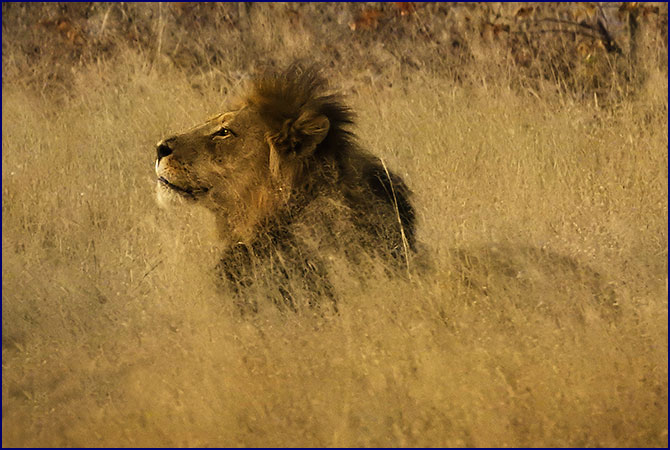
Nxaha |
Nxaha got up, yawned
and stretched like a housecat, and sprayed to mark his territory.
Then he started walking toward us purposefully, his manner
threatening. It was obviously his intent to chase us off, and he
succeeded; as he picked up speed Adam moved the vehicle to avoid
an attack. Apparently content that he had made his point, the lion
lay down again. Julian moved his vehicle closer so the others
could get good photos, but Gina was freaking out so Adam
couldn’t take us nearer.
|
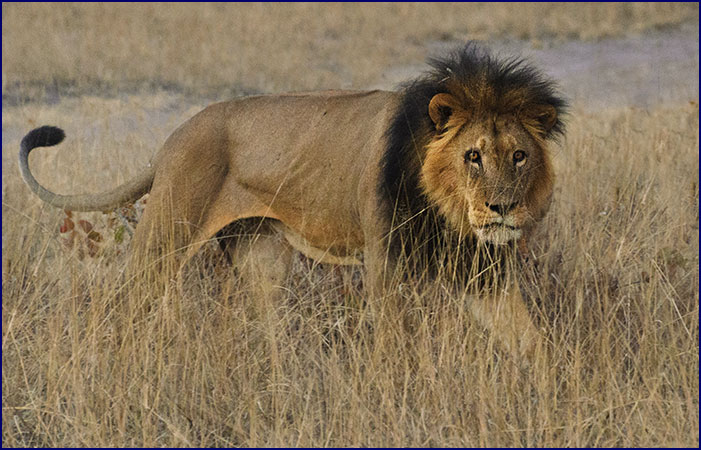
Nxaha
|
David said that Vusa,
the other lion in the coalition, might be nearby as well. Sure
enough, we soon found him sleeping in the tall grass. David
explained that Vusa was placid and calm, not aggressive like
Nxaha. Adam drove closer to the sleeping lion, but again Gina
freaked out. This was getting ridiculous! The other vehicle drove
right up beside him, but because of Gina’s fears we could not.
David tried to calm her down but she was frantic. Going on safari
seemed an odd choice for someone so afraid of animals.
Then Vusa stood up, had a yawn and
a stretch, and walked forward. He had a tawny coat and a
caramel-colored mane. One does not appreciate how large a lion is
until you see one up close. He was magnificent! Suddenly he
stopped and let out a mighty roar, his whole body straining with
the effort. He gave a long series of bellows - a fierce, mournful
sound that reverberated through the night. There is nothing quite
like the roar of a lion; it is the
sound of raw power. When you hear it you know that you are in the
presence of greatness. There is a reason they call the lion the
King of the Beasts!
|
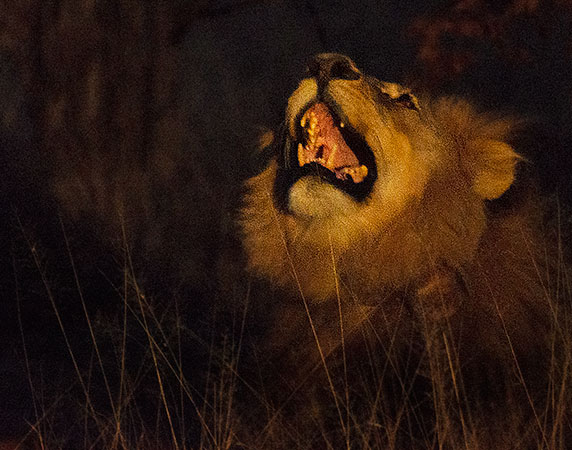
Vusa |
When Vusa finished
his impressive performance, he lay down and closed his eyes. We left
him sleeping and headed back to camp
for drinks and dinner. We recounted the day’s adventures and
compared notes; George, Rosemary and Nick had also
approached an elephant on foot with Julian, and had an experience
much like ours. Between the elephants and the lions, it had been
an outstanding afternoon.
Jineen
had been in the other vehicle in the morning, and had gone walking
with David. He had told them a story: When
God created the hippopotamuses, God wanted them to live on land
but the hippos wanted to live in the water. They couldn’t agree,
so God made a compromise. He said the hippos could live in the
water, but since the crocodile already lived there and ate the
fish, the hippos were not allowed to eat fish, but must come out
of the water and eat the grasses at night. And to make sure the
hippos kept their end of the bargain, He made them have very soft
runny poop and spread it around by flicking their tails, so that
God could check to make sure there were no fish bones in it.
Sitting around the campfire, we
heard the lions calling again, the quintessential sound of Africa.
There was a half-moon shining, and Venus and Jupiter were
bright in sky. We asked our guides
about their scariest ever wildlife encounters, and all of
them told stories involving lions.
Later in our cabin we could hear the elephants going by.
From our verandah we could see them in the moonlight, walking past
not far from our cabin, and we could barely make out more shadowy
shapes by the water hole. We heard the lions in the night,
distant, and again much closer in the wee hours of the morning.
The most exciting sound in the world, and my enduring memory of
Africa.
July 24
Our wake-up call came at
5:45 again; normally I hate getting up that early but in
Africa I never mind – I can hardly wait to see what adventures
the morning will bring. Today we had arranged to pack a lunch and
go on an all-day game drive. Sally, Mike, Jineen, Mary and I
climbed into Adam’s vehicle, and Julian came along as well.
George, Rosemary and Nick were feeling a little tired, so
they planned to go on a morning drive with Quinn, and then stay in
camp for the afternoon. Gina was leaving that morning, so we
didn’t have to worry about her phobias.
It was very windy, and for quite a
while the plains were deserted, with not so much as an impala to
be seen. Julian said that when it is windy the animals tend to
hunker down and not move around much, making them harder to find.
But we did see a great many birds, and spent some time identifying
and photographing them. A few of the new ones we saw included the
southern white-tailed shrike, the fork-tailed drongo, the
red-billed teal, and the Cape turtle dove. An African hawk eagle
soared overhead. I won’t attempt to name all the birds we saw,
but Sally kept an accurate list which I will include at the end as
an appendix.
Sally had started the morning with
81 new birds for the trip, and David had promised she would get to
100 by the end of the day. Adam predicted 120. We were making a
good start. Often, glimpsing an unidentified bird as we went by,
we would call out to Adam, ‘Stop! Back up!’ Then we would
spend a good while with the binoculars, trying to distinguish
between the LBJs (little brown jobs). Was that an arrow-marked babbler or a southern
pied babbler? The only difference might be a tiny stripe under
the bill of the color of its eyes. I found myself increasingly
fascinated with identifying the different birds.
We entered the teak forest, where
we were surrounded by lovely tall trees - it was much prettier
than the mopane-veldt where the tops of the stunted trees had been
eaten off by elephants. The dry leaves were a medley of yellow,
rust and red, like autumn foliage. We passed a number of large
termite hills; when Mary asked Julian about them he gave us an
interesting lecture on the life cycle of termites. The queen is
around 7 inches in length, and lives up to 10 years. All of the
others are workers, and each has a specific task catering to the
needs of the queen. The workers are only about 2 inches long and
live for just a few weeks. Julian told us about how they construct
their mounds and farm food in them; it was fascinating to hear
about their life cycle.
We got a good close look at
several yellow-billed hornbills, perched in a tree regarding us
with tilted heads. With their long black and white tails and
oversized curved beaks they are a quintessential symbol of Africa.
Often they flew alongside the Toyota in distinctive swooping
flight patterns.
|
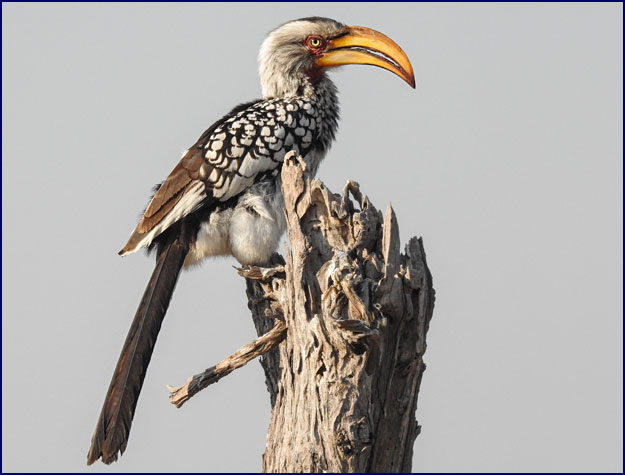
Yellow-billed
Hornbill
|
Julian told us that
the female hornbill finds an abandoned burrow to make a nest in,
and then molts all of her feathers to line it. The male then seals
the nest closed, and she stays inside, safe from predators, to
hatch the eggs and raise the young. Her mate feeds her and the
chicks through a small hole, only opening the nest and letting
them out once the babies are old enough to fly.
A dainty double-banded sand grouse
crossed the road in front of us, with a tiny chick by her side.
They were exquisite. The fuzzy chick crouched down in the leaves,
perfectly camouflaged, and was instantly almost invisible. Julian
carefully parted the grass so we could get a close look at
it.
|
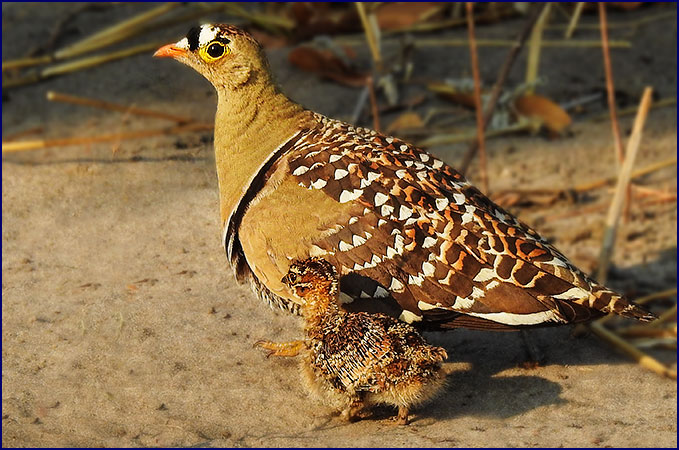
Double-banded
Sand Grouse
|
Suddenly Adam stopped the land cruiser and pointed out an African
Barred Owlet perched high in a tree. It is amazing how the
guides can sight elusive birds and animals while driving! This
lovely little owl peered down at us with a wise expression. A bit
further on we saw a purple roller, much less common than the
lilac-breasted variety. A Gabar Goshawk perched on top of a tree.
|
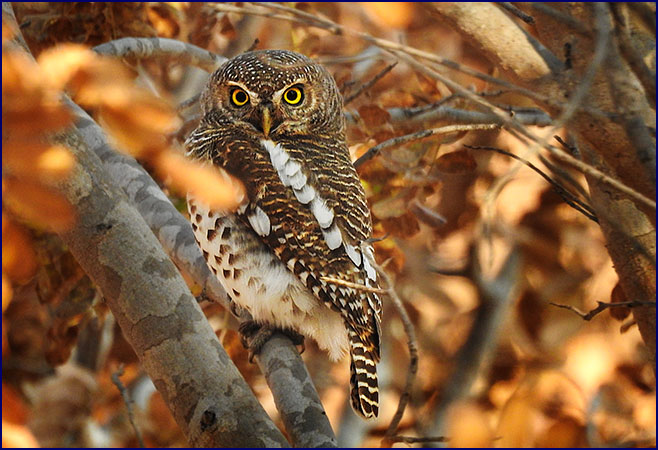
African
Barred Owlet |
Three southern ground
hornbills were running through the underbrush by the road. These
large black birds forage for food on the ground and can live up to
30 years. Julian told us they are endangered, and have become
quite rare. They are cooperative
breeders – each pair is assisted in raising their young by
at least two other birds. With vivid red patches of skin around
their faces and throats, they are not very attractive.
We came to a crossroads, and a
Hwange vehicle was there waiting for us – the driver had brought
Julian a spotting scope. We stopped for tea at a campsite under
the trees. Arrow-marked babblers splashed in a birdbath, and a
squirrel peered out at us from a hollow tree.
|
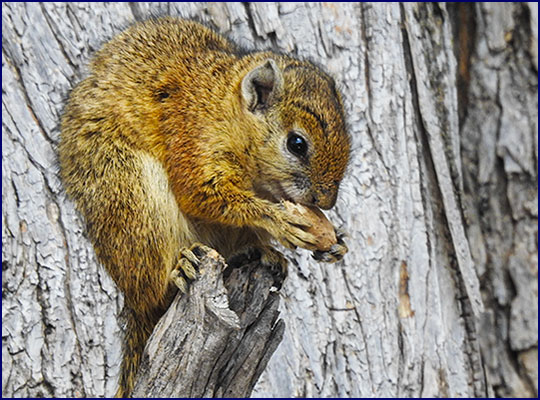
Tree
Squirrel |
At last, the animals!
Having seen none all morning, suddenly in a few minutes
time we saw impala on the right, baby warthogs in the left, zebras
in the road, and elephants crossing just behind them - all at the
same time! The elephants drifted off and disappeared in the
bushes, but we stopped and watched the zebra for quite a while. I
couldn’t get enough of these brightly striped horse relatives,
with their big round ears and Mohawk manes.
We moved a short way
to a nearby waterhole, which was inhabited by some ducks and
Egyptian geese. A blacksmith lapwing waded near the shore, another
bird whose name has been changed by the biologists – it was
formerly known as a blacksmith plover. These handsome black, grey
and white birds are named because of their alarm call, which is
said to sound like a blacksmith’s hammer hitting an anvil.
|
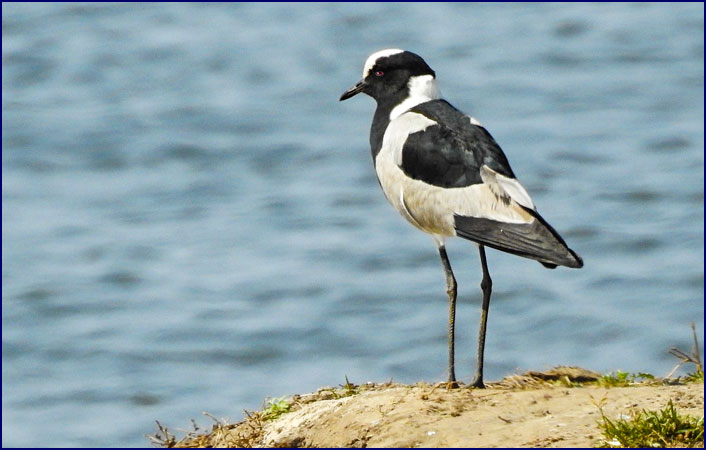
Blacksmith
Lapwing
|
We saw a crested
barbet, an emerald-spotted wood dove, and a brilliant blue-eared
starling. An African hawk-eagle flew overhead, soaring in lazy
circles as he rode the air currents. While Sally and Mary tried to
identify another LBJ, I continued photographing the zebras out the
back of the vehicle.
Further on, we
encountered more elephants. A large female with crooked tusks
mock-charged us; she flapped her ears and waved her trunk to
intimidate us into yielding the right-of-way. It worked. She was
the herd matriarch, protecting her family. More than a dozen
elephants crossed the road in front of us, and we realized they
were clustering around a young baby, shielding it from our view.
There was a flash of
movement, and a dainty female steenbok darted under a bush; these
petite antelopes are less than two feet tall. A few minutes later
we spotted her mate lying in the grass, camouflaged among the
rust-colored mopane leaves, sporting tiny spiked horns. A dwarf
mongoose perched atop a termite mound. This handsome little mammal
is somewhat weasel-like in appearance, lithe and slinky, brown
with reddish eyes.
|
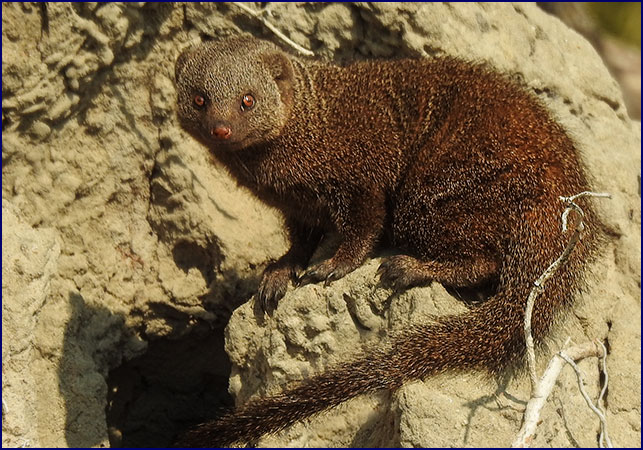
Dwarf
Mongoose
|
We
stopped at the Masuma blind again and there was plenty of action;
the variety of animals to be seen there was amazing. The hippos
were playing, rearing up out of the water in pairs, mouths open
wide as they grappled with each other. A troop of baboons came
down to drink, bringing several small babies with them. Several
large crocodiles lounged along the edge of the water, and we
spotted a baby croc on the far shore. A big monitor lizard walked
along the bank. A group of impala cautiously approached the water,
warily putting their heads down to drink, but jumping back
fearfully at any real or imagined threat. Several waterbuck joined
the impala, drinking side by side with them. An elephant waded in
the shallows, drinking and splashing to cool off. We saw another
new bird for Sally, the water thick-knee. If we had more time we
would have loved to spend a whole day there, watching whatever
came down to the water.
|
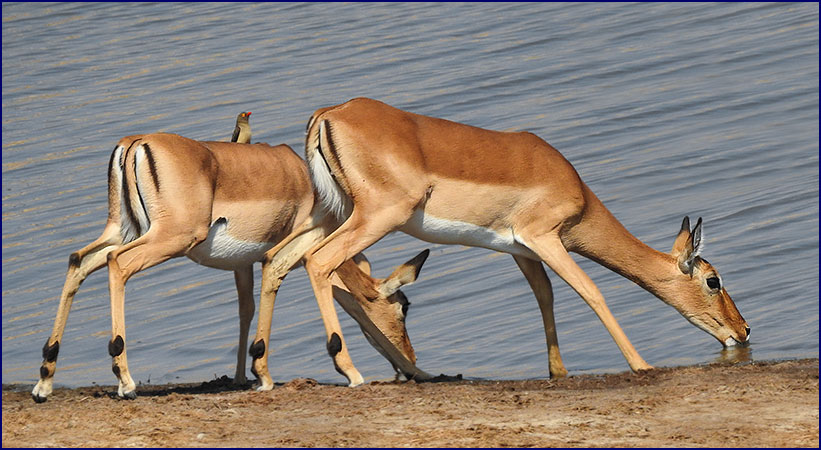
Impala
|
We went on to the
Mandavu dam, the large reservoir we had stopped by when we first
came in to Hwange. As we arrived we saw five giraffes on the
ridge, the first we had seen since the sunset cruise the first
night. They were not very near the road, but we watched from a
distance as they browsed in the trees, their nimble lips neatly
separating the leaves from the thorns.
Coming down to the
edge of the water, we could once again observe an incredible
variety of wildlife from one spot. Ahead of us a narrow island was
inhabited by a raft of sleeping hippos, half a dozen huge
crocodiles, and several yellow-billed storks – they were all
very close together and
apparently unconcerned with each other. A dead tree stood out in
the middle of the reservoir, and two fish eagles perched on a
stick nest high in the top of it, tending their chicks. These
regal black birds with white heads look very much like our bald
eagles, but with the white extending further down their chests.
A goliath heron, the
world’s largest heron, waded in the shallows, along with egrets,
sacred ibis, and African skimmers, among others.
We watched a pied kingfisher hunting out over the water;
this amazing black and white bird would hover in place almost like
a giant hummingbird, and then dive straight down into the water to
grab a fish.
A small group of buffalo came down
to drink, along with a family of warthogs, and a waterbuck dozed
nearby. A baboon
watched us from a nearby tree. We could see a herd of elephants on
the far shore, drinking and splashing at the edge of the water.
The giraffes we had seen earlier made their stately way
along the ridgetop in the distance.
We followed a narrow track through
thick woods to the opposite end of the reservoir; there was a much
greater variety of trees this near the water. A huge candelabra
tree stood near the road, like an overgrown cactus, and a little
tree squirrel peered down on us from on top of it. A rock mongoose
darted over an outcropping, small and quick.
Spotting an unfamiliar bird, once again we asked Adam to
stop and back up - it was a green wood hoopoe, another one for the
list.
|
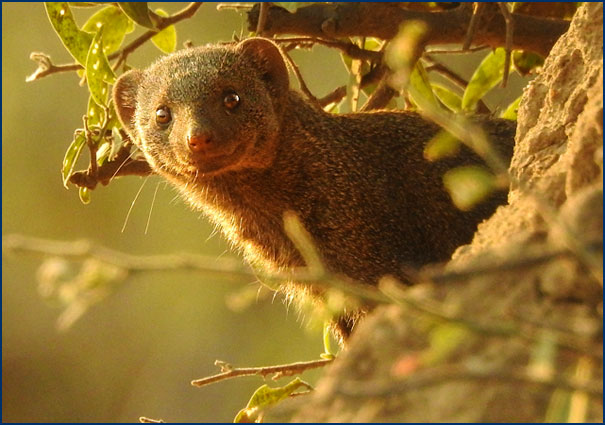
Mongoose |
At the far end of the
reservoir there was a picnic area set on a high balcony
overlooking the water. Bleached skulls of an elephant, a hippo and
a buffalo decorated the platform. Julian and Adam brought out a
delicious lunch the Camp Hwange staff had packed for us, and we
ate while gazing out over the water. Using the spotting scope, we
could see spoonbills and herons on a small island far out in the
reservoir, and spy on the fish eagles in their high nests. With
binoculars we watched the elephants on the far side of the water.
Some very large crocodiles swam in the water straight down below
us.
Adam drove us down to the very end
of the reservoir. An African harrier hawk walked along the shore,
picking his way through the mud. We were much closer now to the
elephants on the far shore; when they finished drinking they
turned and filed quietly away in to the trees.
Heading back through the woods,
there was an impressive array of birds. Blue-faced waxbills,
yellow-fronted canaries, a black-backed puffback and white-browed
sparrow weavers. And wait; stop, back up Adam – a Bennett’s
woodpecker, tapping on a tree!
|
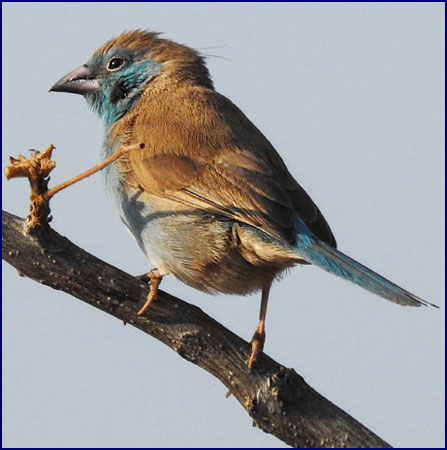
Blue Waxbill
|
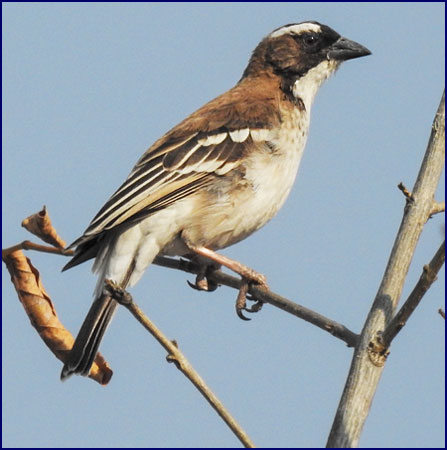
White-browed Sparrow Weaver
|
We heard the
ascending whistling notes of a pearl-spotted owlet. ‘Watch
this,’ Adam told us as he stopped the vehicle. He whistled,
imitating the call, and sure enough the little owl swooped down
straight at us. The tiny pearl-spotted owls are very territorial,
and this one was ready to challenge what he perceived as a rival
encroaching on his territory. We were in awe of Adam’s
owl-calling abilities.
We were running late; Adam said we had to
make the gate at the blind by six o'clock, but we kept seeing
interesting things to stop for; a family of warthogs by the road,
kudus near the reservoir, and a buffalo rolling in the edge of the
water.
|
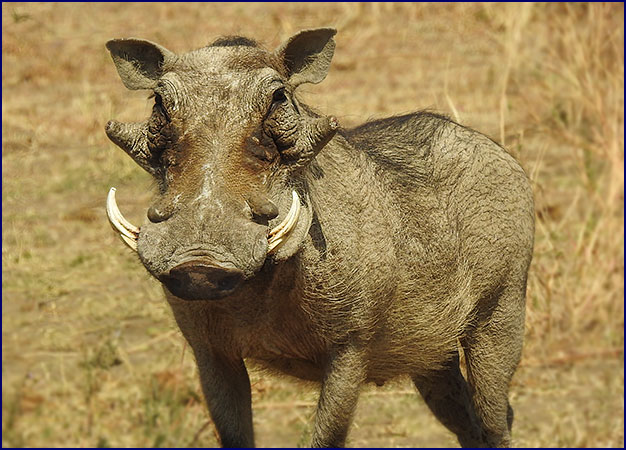
Warthog
|
The giraffes we had
seen earlier were continuing along the ridge, and there were
zebras silhouetted against the skyline. Finally Adam coaxed us to
leave Mandavu by telling us, ‘This is good leopard light.’
We stopped again at the Masuma blind on
the way home. This time there were dozens of elephants there,
lining the whole far bank. We could only stay to watch them for a
few minutes, as Adam said that if we weren’t through the gate
before six we would be shut out. Further on we saw yet another
group of elephants, making their way along a dry riverbed beneath
a red sun setting.
As we neared camp we
met up with Quinn driving the other land cruiser with George,
Rosemary and Nick. ‘Wait - weren’t you all planning on taking
the afternoon off?’ I asked them? ‘FOMO,’ Nick answered
succinctly. Fear of Missing Out.
Gathered around the
campfire back at Camp Hwange, we recounted the day’s adventures.
Sally reported thirty new birds for the day, bringing the total to
111. George, Rosemary and Nick had gone on a walking safari with
Quinn, and Nick’s GPS showed they had covered six miles. We’d
had a great day, but I was sorry to have missed that!
We all sat around the long dining
table and had an excellent meal. I pulled two ticks out of my
hair, despite Julian saying it was the wrong time of year for
them. They were quick little buggers, a bit of African wildlife I
hadn’t bargained for.
After dinner we sat around the
fire a while longer, and then the guides escorted us to our
cabins. We paused for an elephant that crossed in front of us as
it walked right past Mary’s room. During the night we heard the
elephants again, very loud, trumpeting and splashing at the water
hole. We listened to them for a long while.
Later:
Several weeks after returning
home, we learned the tragic news that Quinn, one of our guides at
Camp Hwange, was killed by a lion while on a walking safari. He
was leading a group of guests on foot when they came upon a pride
of lions. Nxaha, the same lion who had chased our vehicles, got up
and moved toward the group. At Quinn’s instructions his guests
made noise to deter the lion, and it turned away. Quinn let off a
loud noise-making device to be on the safe side and the lion
backed off even more. But then, suddenly and without warning,
Nxaha turned and charged. With no time to use his rifle, Quinn
moved between the lion and his guests. The lion attacked him,
biting him severely, and tragically Quinn was killed.
He was a fascinating person who cared deeply about
conservation and wildlife. We mourn his passing, but take some
comfort from the fact that he died doing the job that he loved.
|